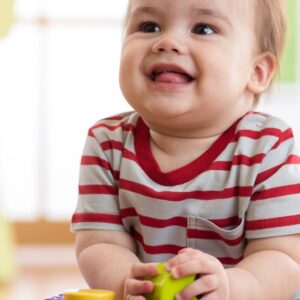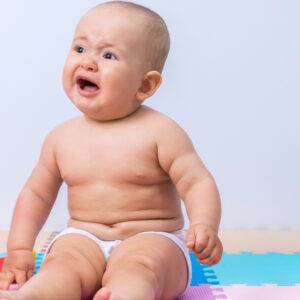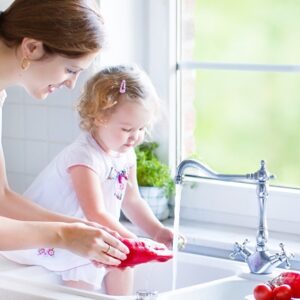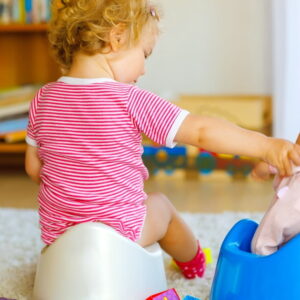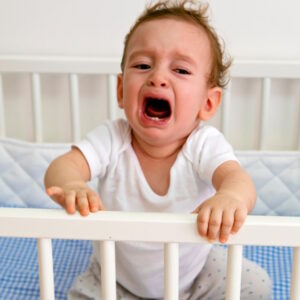As your baby grows and becomes more independent, many exciting things happen. One such important milestone is your child learning how to use the potty. Although exciting, this process can also be stressful at times.
Using a potty is a skill your child will need to learn. How long it takes for them to learn depends a lot on the child, as every child is different.
When is the best time to start potty training? Is is even needed at all, or will the child simply learn it as they grow?
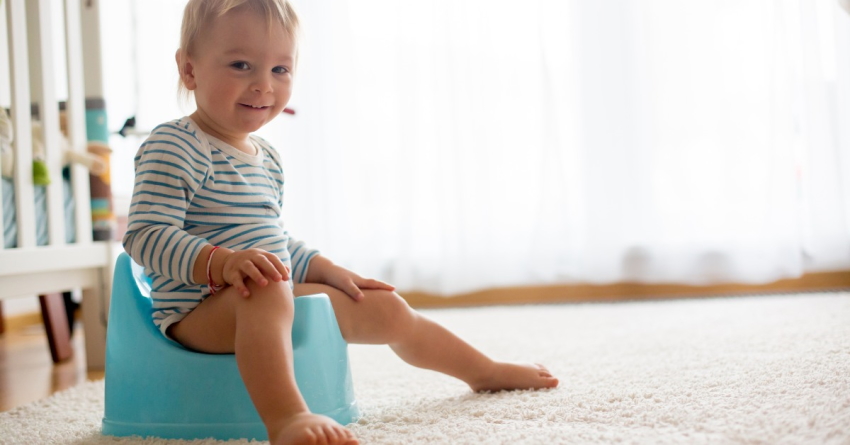
When to Start Potty Training & Learning to Wipe Themselves
Why potty train?
Potty training helps your child recognize their body signals and the need to urinate or have a bowel movement.
Potty training will help your child feel more independent as they won’t need you to change their diapers anymore. In addition, mastering this skill has a positive impact on your child’s confidence.
If you think about it, toddlers LOVE being able to master things. Honestly, many toddlers actually believe that they master a lot of things they obvioulsy don’t. My youngest son, for example, literally jumped into the pool at 2 years old and when I picked him up, he happily told me “I can swim”. Which he certainly couldn’t. I put him in a toddler swim class the next day.
So, teaching a young kids that wants to, how to use the potty, can be a very poitive thing for them.
Is potty training needed, or will children learn automatically?
According to some, it is not necessary to “train” your child to use the toilet as they will learn naturally and at their own pace. Once the child is ready, the whole process is relatively easy. If the child is not ready and you pressure them to learn, this process will be challenging and stressful for both the child and you.
For example, Dr. Laura Markham suggests that moving from diapers to using the toilet independently is a natural process. Humans have been doing it for a long time, and every child eventually gets out of diapers. This is the main idea behind child-led potty learning.
Although this is sometimes not considered potty training as such because you let your child lead and set the pace, there is still some advice on what you, as a parent, should do to support your child during this process and facilitate learning.
When do children obtain bladder and bowel control?
As it is always emphasized when it comes to children, they develop at different rates. However, children don’t have control over their bladder or bowel movements before they are one year old. Between 12 months and 18 months of age, there is still very little control. Therefore, potty training before this age may not be very successful, or it may take a long time before the child learns to recognize when they need to use the potty.
Most children develop bladder and bowel control when they are 24 to 30 months old, but it usually takes longer to obtain nighttime bladder control.
Children can usually control their bowels before they can control their bladder. According to The National Health Service (NHS): most kids stop having bowel movements at night by age 1; by age 2, some kids will stay dry (with no accidents) during the day, even though this is still quite early for most kids; 9 out of 10 children by age 3 will stay dry most days (but some accidents may still happen now and then); most children will be reliably dry during the day by age 4.
Girls usually obtain bladder control before boys do. Incontinence may be diagnosed if girls still have urinary control issues after the age of 5 and after the age of 6, in the case of boys.
It usually takes longer for bladder control at night to develop. Most kids obtain nighttime bladder control between the ages of 3 and 5, but up to 1 in 5 kids sometimes still wet the bed when they are 5 years old. According to the American Academy of Pediatrics, around 20% of children still wet the bed at 5 years old, and about 10% at 7 years old. Some sources indicate that bedwetting is considered normal up to at least the age of 5.
At the same time, Mayo Clinic states that bedwetting before the age of 7 isn’t generally a cause of concern because the child may still be developing nighttime bladder control.
Some experts believe that an earlier start of toilet training, which is widespread in some cultures, leads to children acquiring complete bladder control at a younger age. For example, in one study conducted with the Vietnamese population, it was shown that infants were able to achieve a degree of bladder control and use a potty by the age of 9 months.
When is the best time to potty train?
There is not a straightforward answer when it comes to this topic, and there are also big differences across cultures.
In Western societies, toilet training usually starts when the child is between 24 and 36 months old. Generally, the average age for potty training is 27 months. When observing historical trends, it was noticed that toilet training occurs at a later age than in the past.
On the other hand, in some countries, infant toilet training is widespread and a norm. For example, in parts of Asia and Africa, assisted toilet training starts when the baby is one to three months old.
While there is research that shows that children who are trained at a younger age (earlier than 27 months in one particular study) are not less likely to have accidents or experience stool refusal than those who are trained later (after 27 months), there is also research that suggests that long-term problems with incontinence are less likely in children who train earlier.
Several studies indicate that when toilet training is started at an earlier age, it takes much longer to complete. If the training is started when a child is older, the child is more likely to learn faster and require less assistance. But on the other hand, there is also research data that indicates that it may be beneficial to start potty training before the child is 2 years old (24 months).
As you can see, the opinions on the best age for potty training vary. Remember that you should focus on your child’s individual signs of readiness and start when it seems to you that your child may be ready.
The best time to start also depends on your goals. For example, some parents want to achieve complete toileting independence, which means they will have to wait a bit longer until their child reaches some key developmental milestones. On the other hand, some parents, such as those that practice infant toilet training, have different goals when they start potty training, such as parent-assisted dryness.
Another important thing to keep in mind is to start when your child is not going through a period of significant change, which is overwhelming for children on its own, and learning a new skill at the same time would just make it worse.
And probably the most important, the timing depends on when your child is ready.
Signs that my child is ready for potty training
When learning to use the potty, children should be both physically and emotionally ready. Sometimes, even though the child is physically ready to use the potty, they are still not emotionally there.
Several signs show your child may be ready for potty training. Your child may be ready when they:
- Have developed physical skills necessary for potty training, such as walking and sitting down
- Can control the muscles used for going to the potty
- Recognize and communicate when the bowel movement or urine is coming
- Imitate your or older children’s toileting behavior
- Express an interest in potty training, asking to use a potty chair or to wear “big kid” underwear
- Follow you to the bathroom to see how the toilet is used
- Ask to have their diaper changed
- Stay dry for at least two hours at a time, or during naps or overnight
- Can follow simple instructions
- Pull pants up and down
- Want to do things independently or to get a praise
Who takes longer to potty train—boys or girls?
According to the American Academy of Pediatrics (AAP), overall, gender doesn’t have a significant impact on when the child will be fully potty trained.
Some population studies showed that boys tend to complete toilet training approximately six months later than girls. This may be due to boys being more physically active and showing less interest in using the potty or because girls tend to be a bit more advanced when it comes to reaching certain milestones, such as in language development.
However, AAP emphasizes that population studies are not representative of individuals and that other individual factors may have a stronger impact on your child’s readiness for potty training.
Therefore, the difference between boys and girls is not so important, and you shouldn’t be focused on it or worried about it.
When can children wipe themselves?
It may be easy to think that you might as well teach your child to wipe themselve at the same time as teaching them to use the potty. However, this is probably too much at the same time for many children, depending on age.
When to start potty training is one thing, wiping themselves is another.
The age at which children learn to wipe themselves independently varies.
According to some sources, most children will be able to wipe their bottoms by the age of 4-5, although even then, they may need some help from time to time. However, because of individual differences, it may take your child a bit longer to learn how to wipe themselves properly after a bowel movement.
Wiping after peeing is easier. Girls will be ready to wipe themselves from the front, and boys will be able to shake their penis dry, possibly already around the age of 2.
You can see that there is no exact age at which your child will learn how to wipe themselves. Often, children are ready before the parents even try, so you can always test it, and if you see they aren’t ready yet, try again at some point later.
You may try teaching your child to wipe their bottom when they are 3-4 years old, but if they are 5 or even a bit older and still haven’t mastered it, don’t be immediately discouraged. Instead, give them a bit more time.
How to teach kids to wipe themselves
- Encourage your child to wipe themselves
- Give them opportunities to practice with your assistance, even when they don’t know how to do it thoroughly yet
- Better start earlier than later
- Teach them how much toilet paper they need (one way to do it is to use a sticker or a piece of tape to make a mark on the wall showing them how far they need to pull the toilet paper before ripping it)
- Teach them how to fold the paper
- Teach them the wiping motion (from front to back)
- Explain to your child what they need to do and how to do it properly by giving positive directions such as “wipe until the tissue is clean”
- Teach them to repeat the process as many times as needed until the tissue is clean
- Teach them to throw the toilet paper in the toilet, and when they are done, close the lid and flush
- When they are done, check whether they are clean or not
- Use praise
- Be patient
Takeaway: When to Start Potty Training
When you feel that your child – and you – are ready to start potty training, there are several methods to choose between. Internet is flooded with potty training methods that will get your toddler potty trained in no time. There are pros and cons to all methods, and we go through a number of the most common potty training methods here.
Read Next
- 4 Potty Training Methods: Pros, Cons and How-to
- How to Prepare for Potty Training
- Diaper Change Nightmare
- Newborn Baby Cries Before Urinating: 5 Important Reasons
References
- American Academy of Pediatrics. (2021, December 22). Bedwetting: 3 common reasons & what families can do.
- American Academy of Pediatrics. (2016, August 8). Is it true that boys are usually toilet-trained later than girls?
- Blum, N. J., Taubman B., & Nemeth, N. (2003). Relationship between age at initiation of toilet training and duration of training: A prospective study. Pediatrics, 111(4), 810-814.
- Blum, N.J., Taubman, B., & Nemeth, N. (2004). Why is toilet training occurring at older ages? A study of factors associated with later training. The Journal of Pediatrics.145(1),107-111. DOI:10.1016/j.jpeds.2004.02.022
- Duong, T. H., Jansson, U. B., Holmdahl, G., Sillén, U., & Hellström, A. L. (2013a). Urinary bladder control during the first 3 years of life in healthy children in Vietnam–a comparison study with Swedish children. Journal of Pediatric Urology, 9(6 Pt A), 700-706. doi:10.1016/j.jpurol.2013.04.022
- Duong, T. H., Jansson, U. B., & Hellstrom, A.L. (2013b) Vietnamese mothers’ experiences with potty training procedure for children from birth to 2 years of age. Journal of Pediatric Urology, 9(6), 808–814.
- Mottram, R. (2021, July 21). Ask Rebecca: At what age can children wipe themselves?
When did you start potty training? Or plan to start? And how? Share your experiences by leaving a comment below!

Paula Dennholt founded Easy Baby Life in 2006 and has been a passionate parenting and pregnancy writer since then. Her parenting approach and writing are based on studies in cognitive-behavioral models and therapy for children and her experience as a mother and stepmother. Life as a parent has convinced her of how crucial it is to put relationships before rules. She strongly believes in positive parenting and a science-based approach.
Paula cooperates with a team of pediatricians who assist in reviewing and writing articles.

